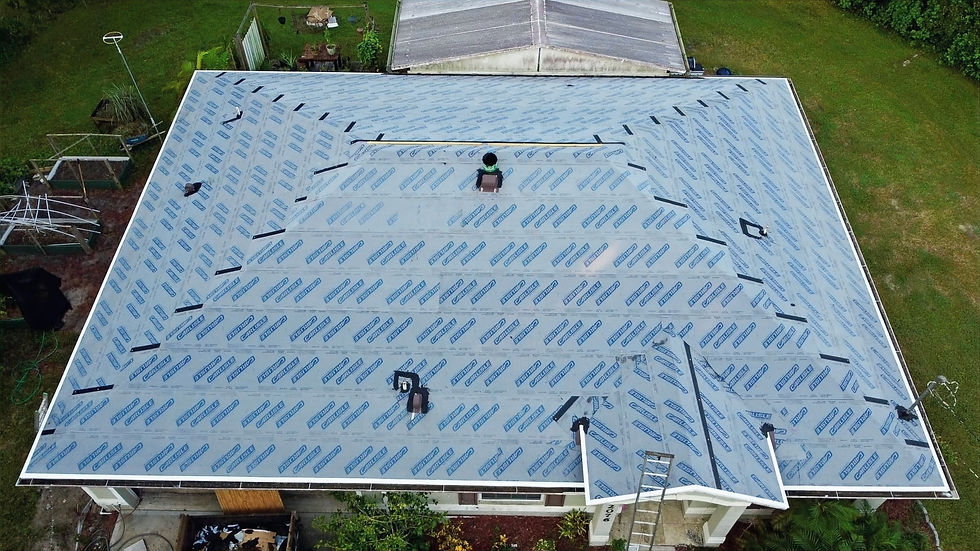Choosing Roof Underlayment in Florida: Which is Best?
- JoeTriangleRoofing

- Oct 21
- 3 min read
Updated: Oct 22

When it comes to roofing in Florida, choosing the right underlayment is just as important as selecting quality architectural shingles. Florida’s extreme weather, including intense sun, wind, rain, and hurricanes demands a roofing system built for long-term protection. Your underlayment is the hidden layer that protects your home or commercial business from water coming in. It supports the entire roof system.
At Triangle Roofing, Inc., our father and son team helps homeowners throughout Volusia, Flagler, and St. Johns Counties make smart roofing choices. Here's what you need to know about the different types of underlayment for your Florida roof.
What Is Roof Underlayment?
Roof underlayment is a waterproof or water-resistant barrier installed between your roof’s decking and the final roofing material (like asphalt shingles or metal roofing panels). It acts as your roof’s second line of defense keeping out wind-driven rain, reducing water damage, and improving overall roof performance.
Why the Right Underlayment Matters
Florida’s roofing systems must be built to withstand:
High UV exposure and heat
Heavy rain and tropical storms, especially near the coast
Sub-tropical humidity and moisture
The right underlayment improves your roof’s lifespan and helps prevent leaks, mold, and structural damage. It can also impact how your roof performs during a storm—and whether it meets local building codes or insurance requirements.
Types of Roof Underlayment for Florida Homes
1. Felt Underlayment (Asphalt-Saturated Felt)
Also called tar paper, felt is the traditional choice for roof underlayment.
Pros:
Affordable for most properties
Easy to install, but may take more time
Time-tested durability
Cons:
Heavier and prone to wrinkling
Absorbs water if exposed
Shorter lifespan compared to synthetic
Felt underlayment is still used today, especially in budget-conscious roofing projects, but many homeowners are upgrading to synthetic materials.

2. Synthetic Underlayment
Synthetic underlayment is made from polypropylene or polyethylene, offering superior strength and weather resistance. Triangle Roofing often chooses this option for our roofing projects. Why do we use it?
Tear-resistant and lightweight
Water-resistant and mold-proof
Longer lifespan
Less wrinkling, safer for roofers to walk on
Popular products like Owens Corning Titanium and Quick-Felt have UV resistance and weatherability.
3. Peel-and-Stick Underlayment (Self-Adhering)
This high-performance option adheres directly to the roof deck, forming a seamless waterproof seal. A favorite of Triangle Roofing Inc. is Carlisle WIP Underlayment.
Pros:
No nails required
Ideal for vulnerable roof areas (valleys, eaves, skylights)
Superior wind and water protection
Florida Building Code-approved in most counties
Cons:
May have a higher upfront cost
Requires expert installation for proper adhesion
Peel-and-stick underlayment is ideal for hurricane-prone regions and offers unmatched leak prevention when installed correctly. We recommend this for many of our roofing clients. If you lose some shingles, in a storm you can rest assured the water will stay out!
What About Flat Roofs?
Flat and low-slope roofs require specialized underlayment systems, often involving modified bitumen or TPO membranes. These applications need a professional installation. Triangle Roofing has the expertise to ensure your flat roof is sealed tight and built to last. We are the company other roofers call for their flat roof jobs!
Underlayment Cost Comparison
Underlayment Type | Cost | Lifespan | Water Resistance | Ideal For |
Felt | Low | 10–15 years | Moderate | Basic shingle roofs |
Synthetic | Moderate | 25+ years | High | Florida shingle or metal roofs |
Peel-and-Stick | High | 25+ years | Excellent | Storm-prone or high-wind areas |
While felt is the most affordable, synthetic and peel-and-stick offer long-term savings with better durability and performance in Florida’s climate. We choose peel-and-stick for our own homes!

What’s The Best Underlayment for Your Roof?
The best underlayment for your Florida roof depends on:
Your roof’s slope and design
Local building codes
Insurance requirements
Your budget and long-term goals
At Triangle Roofing, Inc., we’ll help you choose the right materials to maximize performance and protection. Whether you’re installing a new build roof or replacing an old one, we’re here to make sure it’s done right.
Contact Joe Delia today to schedule your free estimate:
(386) 673-6600



Comments